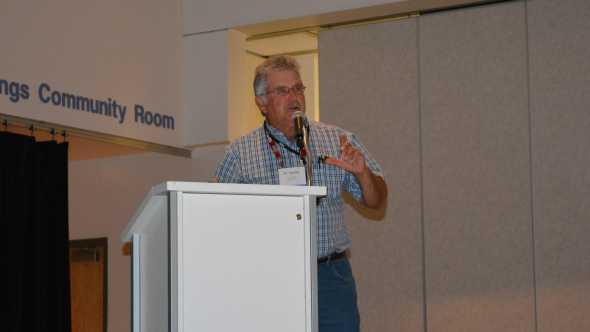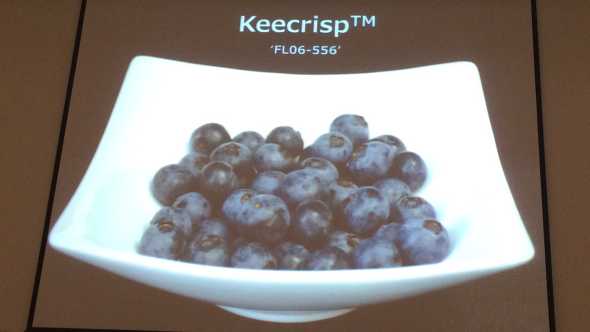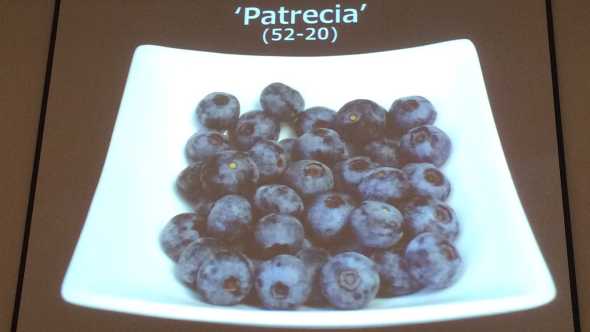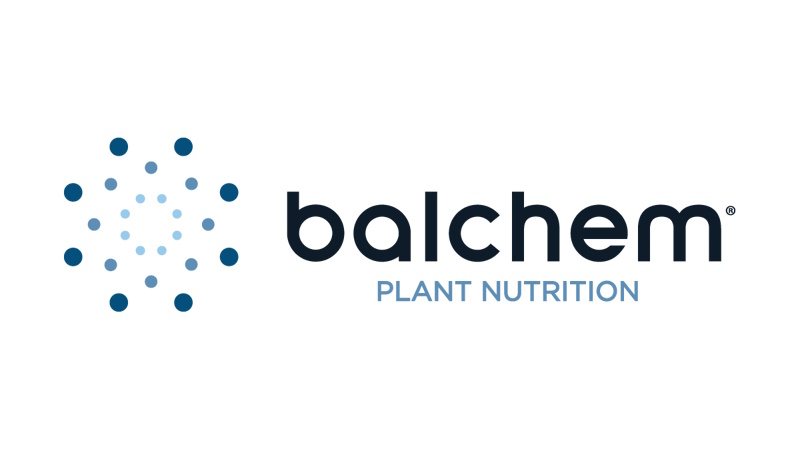El Niño’s Naughty Nature Causing Concern For Florida Blueberry Crop

UF/IFAS researcher Jeff Williamson discusses the performance of grafted southern highbush blueberries during the Florida Blueberry Growers Association Spring Meeting.
Photo by Paul Rusnak
Producing and delivering a successful blueberry crop to market is not for the faint of heart. Factor in this year’s super-sized El Niño event and you have all the makings of what could be a cardiac calamity for many growers.
This was top of mind for those in attendance at the Florida Blueberry Growers Association Spring Meeting at Hillsborough Community College’s Trinkle Center in Plant City.
All eyes and ears were open as Dr. Gerard Krewer, Horticulture Professor Emeritus, University of Georgia, took the stage to present how this year’s weather and dormancy breaking treatments are affecting this season’s blueberry crop in Florida and Georgia. “I’m the ‘Doctor Doom’ today,” Krewer commented as he introduced himself.

Gerard Krewer
Photo by Paul Rusnak
Krewer pointed to El Niño and global warming as prime factors greatly impacting not only this season, but also how growers will have to approach planting and production decisions going forward. “The climate seems to be getting warmer, and we’re going to have to deal with it,” he said.
Regarding blueberry production in Central Florida this season, Krewer called it “the most difficult year I’ve ever seen, especially south of I-4.”
How is the Central Florida crop faring so far? According to Krewer:
- Most of the acreage had no significant winter chilling prior to Dormex/Budpro (hydrogen cyanamide) application. Results are variable.
- The bloom is about three weeks later than usual on Jewels and Emeralds.
- Yields will be down due to Dormex/Budpro injury and chilling problems.
- Evergreen varieties are becoming a significant factor. Some new varieties, such as Chickadee, are looking very good and will be on time in March and April.
North Florida acreage seems to have weathered the storm a little better, Krewer said.
- Bloom is about two weeks later than normal on most farms (Jewel is at about 10% and Emerald is at about 25% bloom).
- Less Dormex/Budpro damage than in Central Florida.
- Overall, there is good crop prospects.
Creeping further north to Alma, GA, Krewer said reports on the ground there show the crop is only about 10 days behind schedule compared to last season.
The tricky nature of hydrogen cyanamide (HC) application, especially during a season like this, requires further study and on-farm trials, Krewer said. In the meantime, he had several observations and suggestions.
- In a zero chill hour winter, high volume of finished spray per acre caused more Dormex/Budpro damage.
- Adjust rates for bush size (close off nozzles). Use a maximum of 80 to 100 gallons for big, leafy bushes. Use less for young and defoliated bushes.
- Night applications greatly increased activity in most, but not all cases.
- Early December trials of Dormex/Budpro can be useful in determining potential rates for late December.
- Degree of defoliation is correlated with potential bud damage under low chilling conditions for Jewel and Emerald.
In the end though, Krewer’s take-home message to the crowd was succinct. “Quit planting higher chill varieties in Central Florida. It’s a losing game.”
See page 2 to learn about two new blueberry variety releases for Florida growers.
2 For The Show
Speaking of varieties, UF/IFAS blueberry breeder Jim Olmstead introduced two new selections for Florida growers: Keecrisp and Patrecia. “The idea is develop varieties we can machine harvest,” he said.
According to Olmstead, Keepcrisp (aka, FL06-556) is a low-chill, mid- to late maturing genotype best suited for production in North-Central Florida and South Georgia.
 Some key attributes of this selection include:
Some key attributes of this selection include:
- Crisp texture
- Upright architecture
- High yield when receiving adequate chilling
- Can be grown using hydrogen cyanamide with some yield loss
- Small dry picking scar
- Suitable for machine harvest and fresh marketing
Olmstead said Patrecia (52-20) is unique in that it is not a product of UF trials, but one of a program from Straughn Farms. Named for the wife of industry trailblazer Alto Straughn, Patrecia fits the needs for an early maturing variety. It matures 10 days before Star (similar to Springhigh), but has better fruit quality, Olmstead said.
Despite the challenges, the current state of the Florida blueberry sector is strong, and getting stronger thanks to sound science and research, said Kevin Folta, head of UF/IFAS’ Horticultural Sciences Department. “It’s a good time for the industry. Better times are ahead.”









